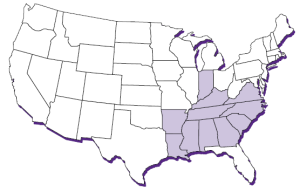Atlanta Hyperbaric sits right in the middle of the stroke belt. I’ve mentioned before that stroke is the third
leading cause of death in the United States. About half a million people have strokes every year and about 150,000 die from stroke. Stroke is more common in men and in African Americans. The best known risk factors for stroke are high blood pressure, cigarette smoking and obesity.
Its been known since the 1950’s that we in the Deep South have a higher than average rate of strokes and death from strokes. A recent study found that if you were born in and continued to live in Alabama, Arkansas, Georgia, Mississippi, North Carolina, South Carolina or Tennessee as an adult, you have about a third greater chance of having a stroke than the rest of the country.
Exactly why we are at such a high risk for stroke remains a mystery, but we do know a few things. At least the rates of stroke seem to be declining a bit. In 1980, African Americans born and living in the stroke belt had a 55% higher incidence of stroke, but by 2000, the incidence had dropped to 34%. The corresponding numbers for whites were 45% in 1980 and 34% in 2000. Even being born outside and living here as an adult carries a higher risk, but the highest risk is lifelong residence. As far as anyone knows, the increase risk of stroke in the stroke belt has nothing to do with social resources, access to medical care, race, sex or age. Whatever causes the increase risk, however, apparently affects us at a very young age and the longer we live here, the worse risk we have. Risk be damned, I like it here. The South’s motto: American by birth, Southern by the grace of God.
At least we have a few things we can do to treat strokes. If the stroke victim can get to the hospital quickly, he can get the clot busting drug, TPA. The venerable drug minocycline shows great promise for stroke treatment even as long as 24 hours after the stroke.
Of course, hyperbaric oxygen is the most underutilized of stroke treatments. Hyperbaric oxygen therapy helps to restore the blood supply to the stroke penumbra. Importantly, the new blood supply to the stroke penumbra is permanent and the recovered brain tissue can learn to take on the function of the adjacent damaged brain by a phenomenon known as brain plasticity. And, although we believe that the earlier that hyperbaric oxygen therapy is started after the stroke the better, good results can still be seen years later.
All I can hope for is that over time, more and more people will learn of the utility of hyperbaric oxygen for treating stroke


